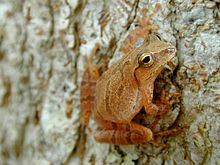Spring peeper
| Spring peeper | |
|---|---|
 |
|
| Scientific classification | |
| Kingdom: | Animalia |
| Phylum: | Chordata |
| Subphylum: | Vertebrata |
| Class: | Amphibia |
| Order: | Anura |
| Family: | Hylidae |
| Genus: | Pseudacris |
| Species: | P. crucifer |
| Binomial name | |
|
Pseudacris crucifer (Wied-Neuwied, 1838) |
|
| Synonyms | |
The spring peeper (Pseudacris crucifer) is a small chorus frog widespread throughout the eastern United States and Canada. They are so called because of their chirping call that marks the beginning of spring. There are two subspecies:
Spring peepers are tan or brown with a dark cross that roughly forms an X on their dorsa (thus the Latin name crucifer, meaning cross-bearer), though sometimes the marking may be indistinct. They have a body length between less than 1 in (25 mm) to 1.5 in (38 mm) and a weight between 0.11 and 0.18 oz (3.1 and 5.1 g).
The species has large toe pads for climbing, although it is more at home amid the loose debris of the forest floor.
The color variations of the P. crucifer are mostly tan, brown, olive green, and gray. Females are lighter-colored, while males are slightly smaller and usually have dark throats. Located by its throat, this frog has a vocal sac which expands and deflates like a balloon to create a short and distinct peeping sound. Only males have the ability to make this loud high-pitched noise, and they use it to attract mates.
Spring peeper, adult, Florida
Spring peepers are distinguished by a dark X-shaped marking on their back
Spring peepers live primarily in forests and regenerating woodlands near ephemeral or semipermanent wetlands. This amphibious species requires marshes, ponds, or swamp regions to support the aquatic environment the eggs and tadpoles need.
In the northern reaches of their range, spring peepers must frequently endure occasional periods of subfreezing temperatures during the breeding season. The species can tolerate the freezing of some of its body fluids, and undergoes hibernation under logs or behind loose bark on trees. It is capable of surviving the freezing of its internal body fluids to temperatures as low as -8 °C. This species frequently occurs in breeding aggregations of several hundred individuals, and commonly breeds in many small wetlands, including swamps and temporary pools and disturbed habitats, such as farm ponds and borrow pits.
The southern spring peeper's habitat includes the Gulf Coast from southeastern Texas to southeastern Georgia and northern Florida, United States. Its northern conspecific occurs in the entire United States east of the Mississippi and spreads to eastern and central Canada.
...
Wikipedia

